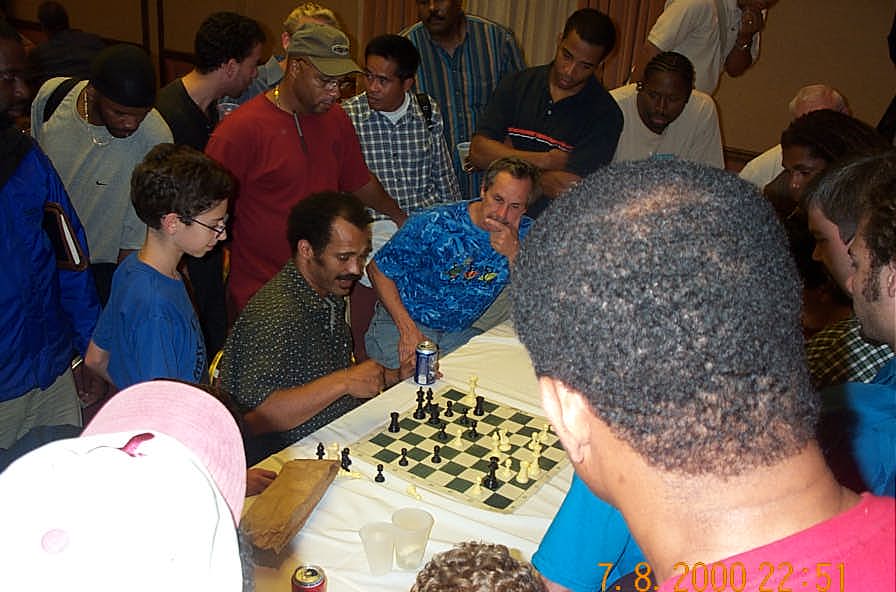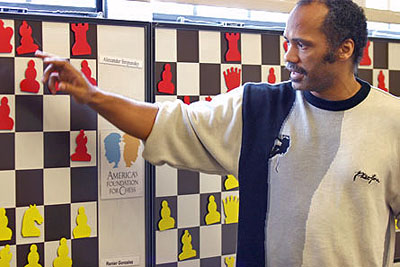Black History Month 2022-Day 28: IM Emory Tate
.jpg)
International Master Emory Tate
Photo by Daaim Shabazz
Before his passing in 2015, International Master Emory Tate was one of the most recognizable figures in the American chess scene. In this last tribute for Black History Month, we will feature the man, the myth, the legend. The legacy continues.
With a warrior persona and his bold pronouncements, he walked tournament halls with the swagger of the Air Force Sergeant that he was. He was particularly proud of being the five-time Armed Forces champion. While Emory was an artful figure, he was also a gladiator at the chessboard. Totally unafraid of trying new ideas (The Emory Tate Variation… 1. e4 Nf6 2. e5 Nd5 3. c4 Nb6 4. a4!? a5 5. Ra3!?), he played for the opportunity to create works of art, and he didn’t disappoint.
~International Master Emory Tate
Born December 27, 1958, on the west side of Chicago, Emory Andrew Tate, Jr. was the son of an attorney (Emory Sr.) and a loving mother (Emma Cox). His father taught him the game at a young age and also his aggressive style. It didn’t take Emory long to begin beating his Dad.
While living in nearby Gary, Indiana, Tate spent much of his earlier time (the late 70s, early 80s) playing in major Chicago tournaments, scorching his higher-rated competition. It was during this time that he created his colorful language, including his trademark, “Triple Exclam.”
During his career, he told me personally his number of GM scalps was at “about 80.” While the Tate-Yudasin game (below) was his career highlight, he has many other games that he liked to show… memorable works of art. Here is one of them at the historic World Open, a popular stage for Emory.

Tate demonstrating his crushing win over GM Sergey Kudrin
at the 2001 World Open, Adams Mark Hotel (Philadelphia)
Photo by Daaim Shabazz
A sesquipedalian at heart, Emory’s theatrical demonstrations, and word-smithing held crowds spellbound and entertained at the same time. The game on display was usually a game of a victimized Grandmaster, but the post-mortem was likened to a theater play with him playing a lead role.
.jpg)
With his prodigious vocabulary, poetic cadence, and multilingual pedigree, he attracted crowds of 40-50 to observe his analysis. A coliseum of players surrounded the animated master as he peppered his commentary with humor, profanity, and sometimes utterings from one of eight languages that he spoke. He sometimes moved pieces forcefully for emphasis and sometimes belt out “exclam,” “double exclam,” and “triple exclam.”
In Triple Exclam: The Life and Games of Emory Tate, Chess Warrior, I mention that he is more of a chess artist than a chess player. There are many anecdotes that drive this point home. One of them was his famous win over strong Grandmaster Leonid Yudasin. Several players have annotated this gem, including GMs Larry Christiansen and Daniel Naroditsky.
In the book, I quote Gregory Serper, who was at the tournament. He mentioned that Tate was showing this game to everyone who would listen. Over the years, he would even sometimes demonstrate the game in Russian or Spanish. However, most times, it was his particularly colorful English. There was one problem that Serper pointed out.
After beating Yudasin, Emory lost any interest in the tournament. Before, after and sometimes even during his remaining tournament games Tate spent time in the lobby or a skittles room demonstrating the game vs. Yudasin to everyone who was willing to see it. And you had to listen to his annotations!
Tate played in tournaments from coast to coast including one U.S. Chess Championship in 2006. He scored a wonderful first-round win over Varuzhan Akobian.
Tate analyzing game vs. GM Varuzhan Akobian

Tate analyzing his win over GM Varuzhan Akobian.
Photo courtesy of John Henderson
Video by Bobby Hall
After Tate passed away on October 17, 2015, a torrent of tributes circulated throughout the Internet. Everyone has an Emory Tate story, but perhaps one tribute from “Erob” was most poignant.
Tate, with that circus energy, like a clown on the high wire with no net underneath, laughing fearlessly at the crowd for refusing his invitation to join him, suffered never for a gentle smile, reassuring that we act by gift of our own wonder. And that Rolls Royce of a brain he carried, thundering down the slope of an unjust society, surely will find respite in the place where all like Socrates must go. But should his ghost decide to linger…our swords will sharpen…and our friendships will grow…in unpredictable ways.
.jpg)
Emory Tate vacationing in Mexico
Photo by Ed Lewis
Tate will go down as one of the most intriguing figures in chess. He wasn’t perfect, nor did he profess to be. He knew his chess was not perfect, but it was his own. He did not earn the Grandmaster title, but gave far more to chess and showed more devotion and love than many Grandmasters. His game collection is a handsome one and if you want to learn more about this legendary figure, check out Triple Exclam. You won’t regret it!
Tate often did his post-mortems in front of an audience, but sometimes there were only a few. It was no less dramatic. Let us leave you with one last example of his attacking skill.
Video by Daaim Shabazz/The Chess Drum


WOW! Thanks for sharing this little known Black History fact about Emory Tate. What a tribute! You, as no doubt countless others, were blessed and honored to have known him personally.
Triple Exclam!!! has much of his life laid out… minus some of the bad stuff people would tell me about after I released the book. It is a tribute, not a tell-all expose’.